Practitioner's Perspectives on Sensory Play for Children with ASD
VerifiedAdded on 2023/04/11
|9
|1762
|115
Report
AI Summary
This report examines practitioners' perspectives on sensory play for children with Autism Spectrum Disorder (ASD), highlighting its benefits within the statutory framework, including communication, physical, social, emotional, and literacy development. It discusses the importance of sensory play in education, emphasizing the role of practitioners and SENCOs in fostering creative and communicative environments. The report explores the correlation between sensory integration and sensory play, noting potential delays in play complexity for children with sensory processing concerns. It also details the contributions of speech therapists in addressing communication difficulties in children with ASD through various therapeutic techniques. Furthermore, the report outlines SEND practices, emphasizing timely intervention, comprehensive delivery, and collaborative working among organizations. Examples of sensory play activities used by practitioners in the classroom are provided, focusing on executive function skills, sensation regulation, and the use of visual aids. The report concludes by referencing key studies and resources related to sensory play and ASD.
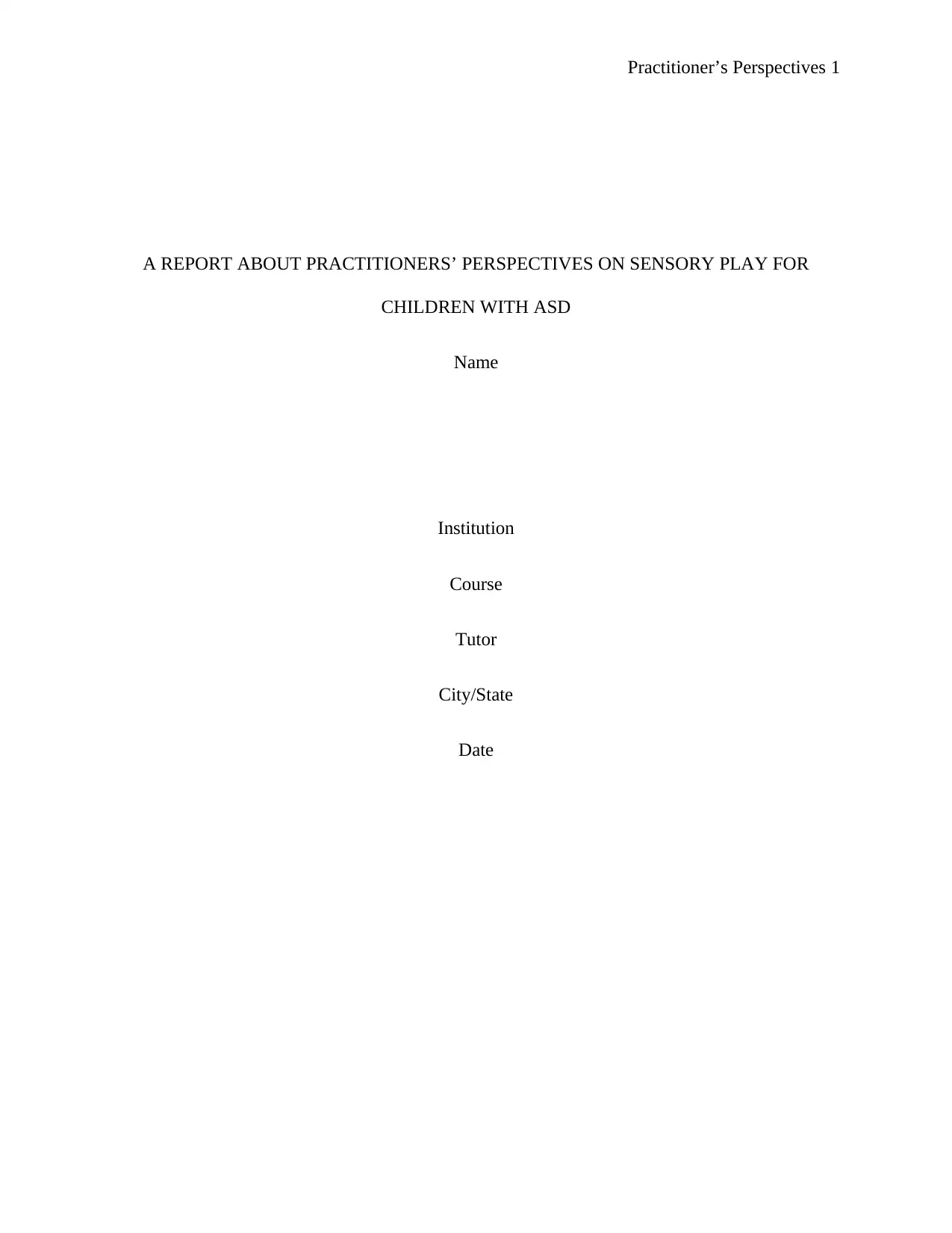
Practitioner’s Perspectives 1
A REPORT ABOUT PRACTITIONERS’ PERSPECTIVES ON SENSORY PLAY FOR
CHILDREN WITH ASD
Name
Institution
Course
Tutor
City/State
Date
A REPORT ABOUT PRACTITIONERS’ PERSPECTIVES ON SENSORY PLAY FOR
CHILDREN WITH ASD
Name
Institution
Course
Tutor
City/State
Date
Paraphrase This Document
Need a fresh take? Get an instant paraphrase of this document with our AI Paraphraser
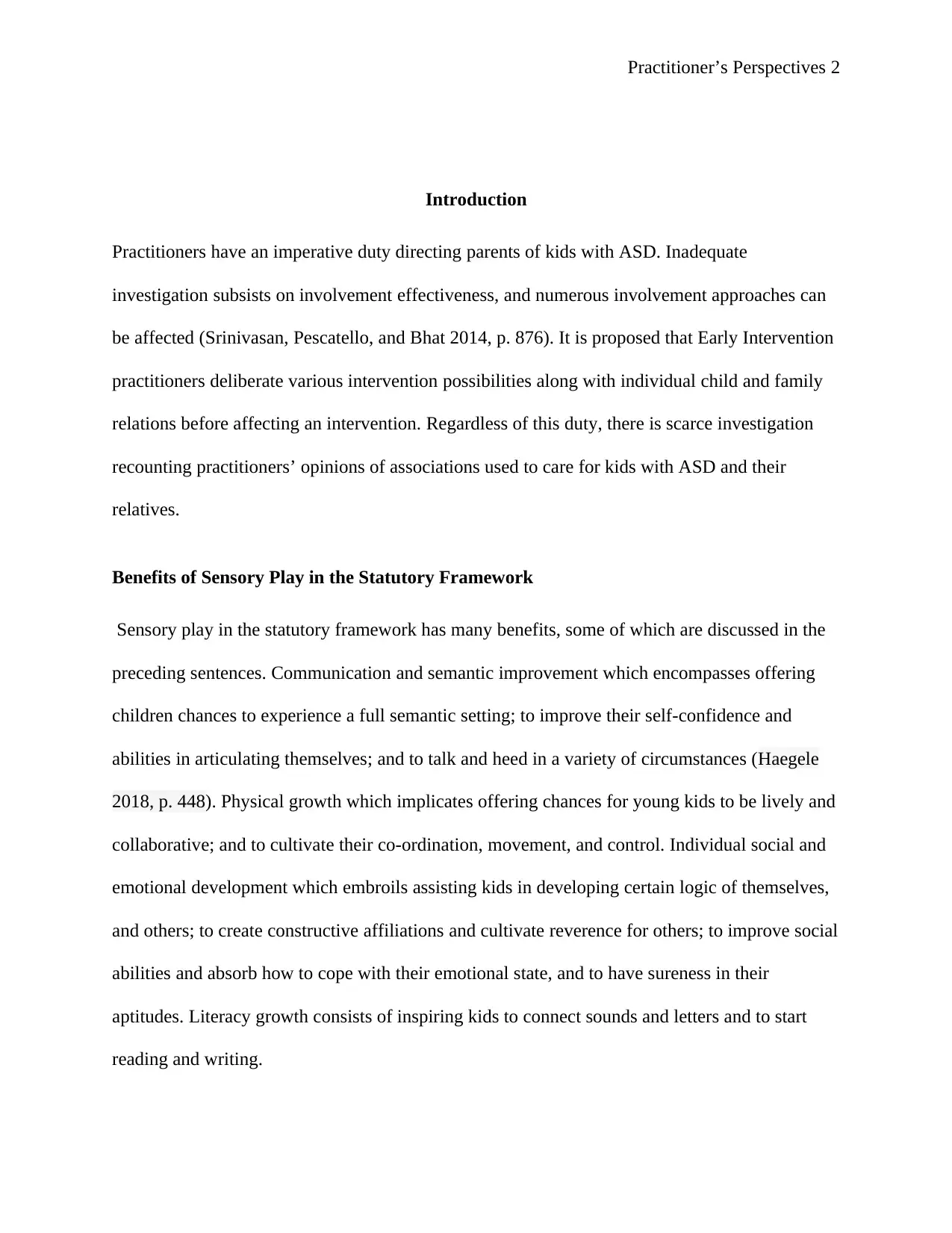
Practitioner’s Perspectives 2
Introduction
Practitioners have an imperative duty directing parents of kids with ASD. Inadequate
investigation subsists on involvement effectiveness, and numerous involvement approaches can
be affected (Srinivasan, Pescatello, and Bhat 2014, p. 876). It is proposed that Early Intervention
practitioners deliberate various intervention possibilities along with individual child and family
relations before affecting an intervention. Regardless of this duty, there is scarce investigation
recounting practitioners’ opinions of associations used to care for kids with ASD and their
relatives.
Benefits of Sensory Play in the Statutory Framework
Sensory play in the statutory framework has many benefits, some of which are discussed in the
preceding sentences. Communication and semantic improvement which encompasses offering
children chances to experience a full semantic setting; to improve their self-confidence and
abilities in articulating themselves; and to talk and heed in a variety of circumstances (Haegele
2018, p. 448). Physical growth which implicates offering chances for young kids to be lively and
collaborative; and to cultivate their co-ordination, movement, and control. Individual social and
emotional development which embroils assisting kids in developing certain logic of themselves,
and others; to create constructive affiliations and cultivate reverence for others; to improve social
abilities and absorb how to cope with their emotional state, and to have sureness in their
aptitudes. Literacy growth consists of inspiring kids to connect sounds and letters and to start
reading and writing.
Introduction
Practitioners have an imperative duty directing parents of kids with ASD. Inadequate
investigation subsists on involvement effectiveness, and numerous involvement approaches can
be affected (Srinivasan, Pescatello, and Bhat 2014, p. 876). It is proposed that Early Intervention
practitioners deliberate various intervention possibilities along with individual child and family
relations before affecting an intervention. Regardless of this duty, there is scarce investigation
recounting practitioners’ opinions of associations used to care for kids with ASD and their
relatives.
Benefits of Sensory Play in the Statutory Framework
Sensory play in the statutory framework has many benefits, some of which are discussed in the
preceding sentences. Communication and semantic improvement which encompasses offering
children chances to experience a full semantic setting; to improve their self-confidence and
abilities in articulating themselves; and to talk and heed in a variety of circumstances (Haegele
2018, p. 448). Physical growth which implicates offering chances for young kids to be lively and
collaborative; and to cultivate their co-ordination, movement, and control. Individual social and
emotional development which embroils assisting kids in developing certain logic of themselves,
and others; to create constructive affiliations and cultivate reverence for others; to improve social
abilities and absorb how to cope with their emotional state, and to have sureness in their
aptitudes. Literacy growth consists of inspiring kids to connect sounds and letters and to start
reading and writing.
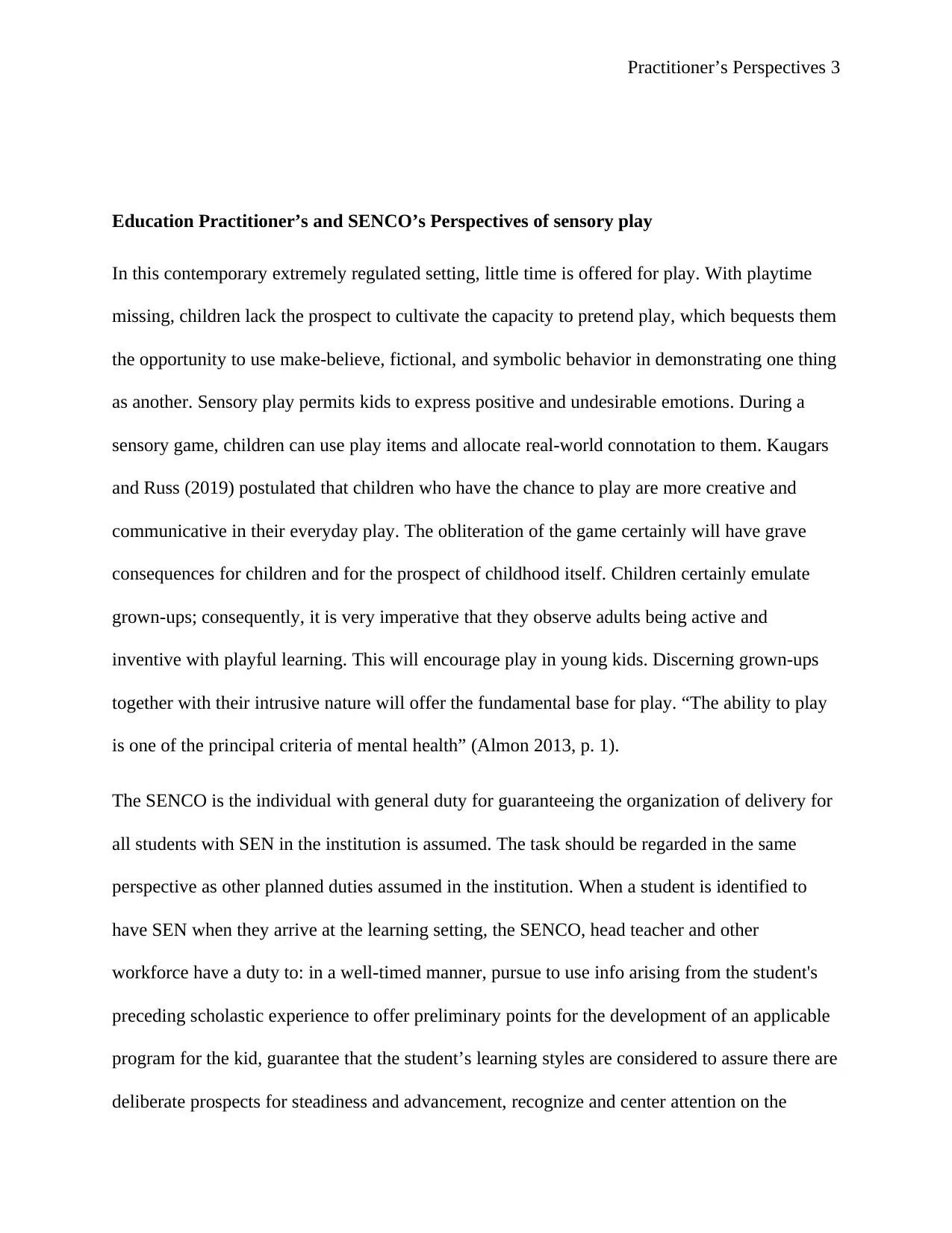
Practitioner’s Perspectives 3
Education Practitioner’s and SENCO’s Perspectives of sensory play
In this contemporary extremely regulated setting, little time is offered for play. With playtime
missing, children lack the prospect to cultivate the capacity to pretend play, which bequests them
the opportunity to use make-believe, fictional, and symbolic behavior in demonstrating one thing
as another. Sensory play permits kids to express positive and undesirable emotions. During a
sensory game, children can use play items and allocate real-world connotation to them. Kaugars
and Russ (2019) postulated that children who have the chance to play are more creative and
communicative in their everyday play. The obliteration of the game certainly will have grave
consequences for children and for the prospect of childhood itself. Children certainly emulate
grown-ups; consequently, it is very imperative that they observe adults being active and
inventive with playful learning. This will encourage play in young kids. Discerning grown-ups
together with their intrusive nature will offer the fundamental base for play. “The ability to play
is one of the principal criteria of mental health” (Almon 2013, p. 1).
The SENCO is the individual with general duty for guaranteeing the organization of delivery for
all students with SEN in the institution is assumed. The task should be regarded in the same
perspective as other planned duties assumed in the institution. When a student is identified to
have SEN when they arrive at the learning setting, the SENCO, head teacher and other
workforce have a duty to: in a well-timed manner, pursue to use info arising from the student's
preceding scholastic experience to offer preliminary points for the development of an applicable
program for the kid, guarantee that the student’s learning styles are considered to assure there are
deliberate prospects for steadiness and advancement, recognize and center attention on the
Education Practitioner’s and SENCO’s Perspectives of sensory play
In this contemporary extremely regulated setting, little time is offered for play. With playtime
missing, children lack the prospect to cultivate the capacity to pretend play, which bequests them
the opportunity to use make-believe, fictional, and symbolic behavior in demonstrating one thing
as another. Sensory play permits kids to express positive and undesirable emotions. During a
sensory game, children can use play items and allocate real-world connotation to them. Kaugars
and Russ (2019) postulated that children who have the chance to play are more creative and
communicative in their everyday play. The obliteration of the game certainly will have grave
consequences for children and for the prospect of childhood itself. Children certainly emulate
grown-ups; consequently, it is very imperative that they observe adults being active and
inventive with playful learning. This will encourage play in young kids. Discerning grown-ups
together with their intrusive nature will offer the fundamental base for play. “The ability to play
is one of the principal criteria of mental health” (Almon 2013, p. 1).
The SENCO is the individual with general duty for guaranteeing the organization of delivery for
all students with SEN in the institution is assumed. The task should be regarded in the same
perspective as other planned duties assumed in the institution. When a student is identified to
have SEN when they arrive at the learning setting, the SENCO, head teacher and other
workforce have a duty to: in a well-timed manner, pursue to use info arising from the student's
preceding scholastic experience to offer preliminary points for the development of an applicable
program for the kid, guarantee that the student’s learning styles are considered to assure there are
deliberate prospects for steadiness and advancement, recognize and center attention on the
⊘ This is a preview!⊘
Do you want full access?
Subscribe today to unlock all pages.

Trusted by 1+ million students worldwide
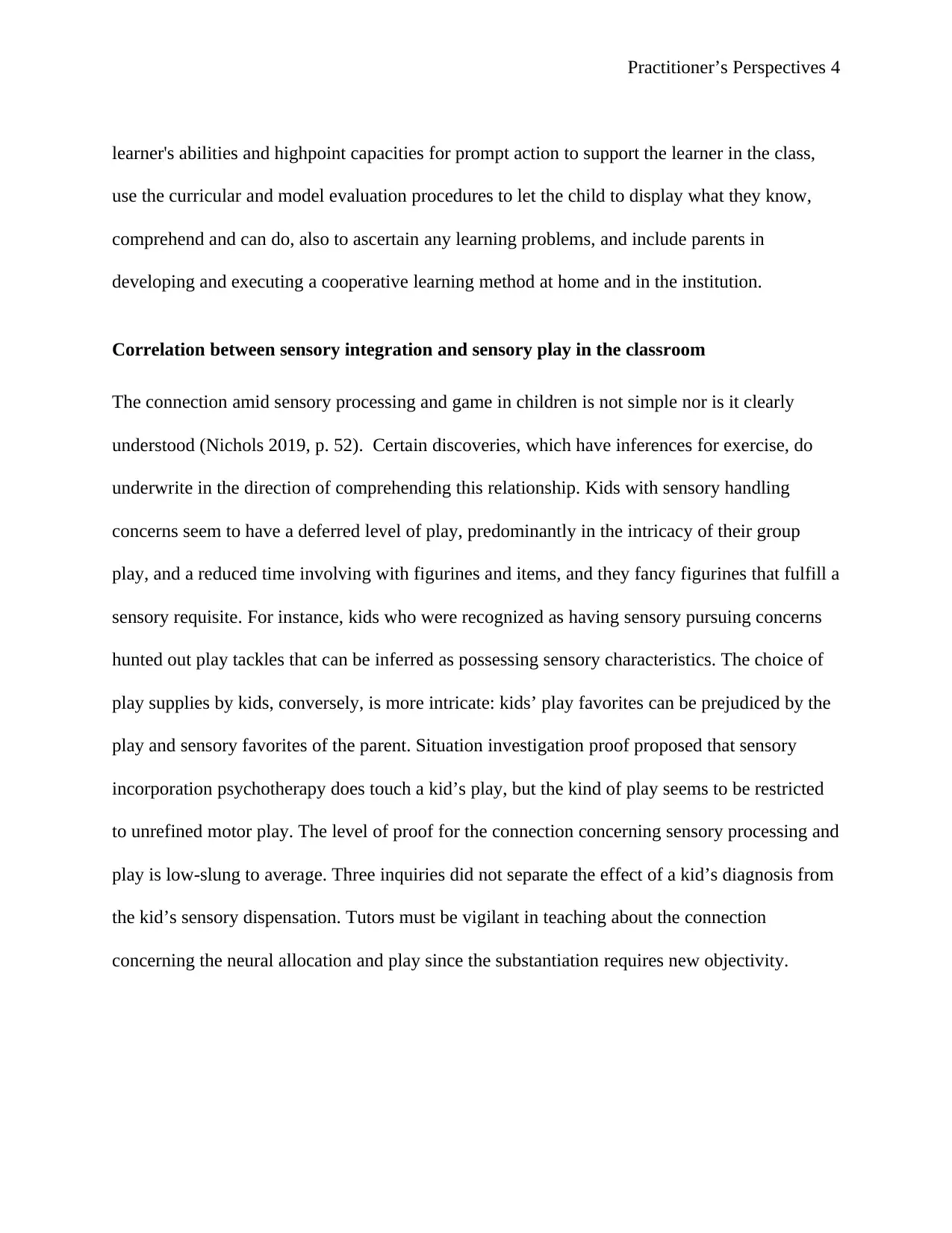
Practitioner’s Perspectives 4
learner's abilities and highpoint capacities for prompt action to support the learner in the class,
use the curricular and model evaluation procedures to let the child to display what they know,
comprehend and can do, also to ascertain any learning problems, and include parents in
developing and executing a cooperative learning method at home and in the institution.
Correlation between sensory integration and sensory play in the classroom
The connection amid sensory processing and game in children is not simple nor is it clearly
understood (Nichols 2019, p. 52). Certain discoveries, which have inferences for exercise, do
underwrite in the direction of comprehending this relationship. Kids with sensory handling
concerns seem to have a deferred level of play, predominantly in the intricacy of their group
play, and a reduced time involving with figurines and items, and they fancy figurines that fulfill a
sensory requisite. For instance, kids who were recognized as having sensory pursuing concerns
hunted out play tackles that can be inferred as possessing sensory characteristics. The choice of
play supplies by kids, conversely, is more intricate: kids’ play favorites can be prejudiced by the
play and sensory favorites of the parent. Situation investigation proof proposed that sensory
incorporation psychotherapy does touch a kid’s play, but the kind of play seems to be restricted
to unrefined motor play. The level of proof for the connection concerning sensory processing and
play is low-slung to average. Three inquiries did not separate the effect of a kid’s diagnosis from
the kid’s sensory dispensation. Tutors must be vigilant in teaching about the connection
concerning the neural allocation and play since the substantiation requires new objectivity.
learner's abilities and highpoint capacities for prompt action to support the learner in the class,
use the curricular and model evaluation procedures to let the child to display what they know,
comprehend and can do, also to ascertain any learning problems, and include parents in
developing and executing a cooperative learning method at home and in the institution.
Correlation between sensory integration and sensory play in the classroom
The connection amid sensory processing and game in children is not simple nor is it clearly
understood (Nichols 2019, p. 52). Certain discoveries, which have inferences for exercise, do
underwrite in the direction of comprehending this relationship. Kids with sensory handling
concerns seem to have a deferred level of play, predominantly in the intricacy of their group
play, and a reduced time involving with figurines and items, and they fancy figurines that fulfill a
sensory requisite. For instance, kids who were recognized as having sensory pursuing concerns
hunted out play tackles that can be inferred as possessing sensory characteristics. The choice of
play supplies by kids, conversely, is more intricate: kids’ play favorites can be prejudiced by the
play and sensory favorites of the parent. Situation investigation proof proposed that sensory
incorporation psychotherapy does touch a kid’s play, but the kind of play seems to be restricted
to unrefined motor play. The level of proof for the connection concerning sensory processing and
play is low-slung to average. Three inquiries did not separate the effect of a kid’s diagnosis from
the kid’s sensory dispensation. Tutors must be vigilant in teaching about the connection
concerning the neural allocation and play since the substantiation requires new objectivity.
Paraphrase This Document
Need a fresh take? Get an instant paraphrase of this document with our AI Paraphraser
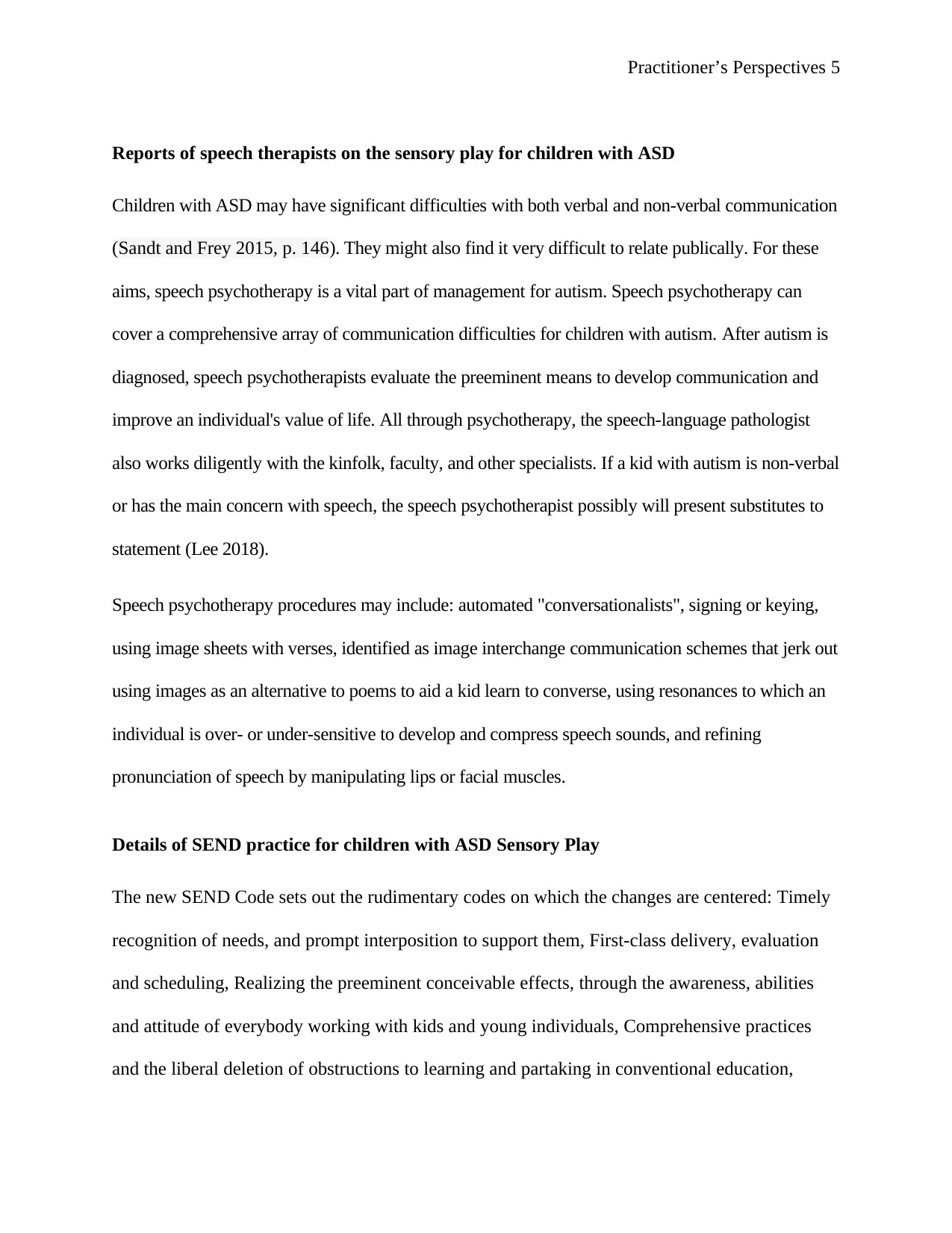
Practitioner’s Perspectives 5
Reports of speech therapists on the sensory play for children with ASD
Children with ASD may have significant difficulties with both verbal and non-verbal communication
(Sandt and Frey 2015, p. 146). They might also find it very difficult to relate publically. For these
aims, speech psychotherapy is a vital part of management for autism. Speech psychotherapy can
cover a comprehensive array of communication difficulties for children with autism. After autism is
diagnosed, speech psychotherapists evaluate the preeminent means to develop communication and
improve an individual's value of life. All through psychotherapy, the speech-language pathologist
also works diligently with the kinfolk, faculty, and other specialists. If a kid with autism is non-verbal
or has the main concern with speech, the speech psychotherapist possibly will present substitutes to
statement (Lee 2018).
Speech psychotherapy procedures may include: automated "conversationalists", signing or keying,
using image sheets with verses, identified as image interchange communication schemes that jerk out
using images as an alternative to poems to aid a kid learn to converse, using resonances to which an
individual is over- or under-sensitive to develop and compress speech sounds, and refining
pronunciation of speech by manipulating lips or facial muscles.
Details of SEND practice for children with ASD Sensory Play
The new SEND Code sets out the rudimentary codes on which the changes are centered: Timely
recognition of needs, and prompt interposition to support them, First-class delivery, evaluation
and scheduling, Realizing the preeminent conceivable effects, through the awareness, abilities
and attitude of everybody working with kids and young individuals, Comprehensive practices
and the liberal deletion of obstructions to learning and partaking in conventional education,
Reports of speech therapists on the sensory play for children with ASD
Children with ASD may have significant difficulties with both verbal and non-verbal communication
(Sandt and Frey 2015, p. 146). They might also find it very difficult to relate publically. For these
aims, speech psychotherapy is a vital part of management for autism. Speech psychotherapy can
cover a comprehensive array of communication difficulties for children with autism. After autism is
diagnosed, speech psychotherapists evaluate the preeminent means to develop communication and
improve an individual's value of life. All through psychotherapy, the speech-language pathologist
also works diligently with the kinfolk, faculty, and other specialists. If a kid with autism is non-verbal
or has the main concern with speech, the speech psychotherapist possibly will present substitutes to
statement (Lee 2018).
Speech psychotherapy procedures may include: automated "conversationalists", signing or keying,
using image sheets with verses, identified as image interchange communication schemes that jerk out
using images as an alternative to poems to aid a kid learn to converse, using resonances to which an
individual is over- or under-sensitive to develop and compress speech sounds, and refining
pronunciation of speech by manipulating lips or facial muscles.
Details of SEND practice for children with ASD Sensory Play
The new SEND Code sets out the rudimentary codes on which the changes are centered: Timely
recognition of needs, and prompt interposition to support them, First-class delivery, evaluation
and scheduling, Realizing the preeminent conceivable effects, through the awareness, abilities
and attitude of everybody working with kids and young individuals, Comprehensive practices
and the liberal deletion of obstructions to learning and partaking in conventional education,
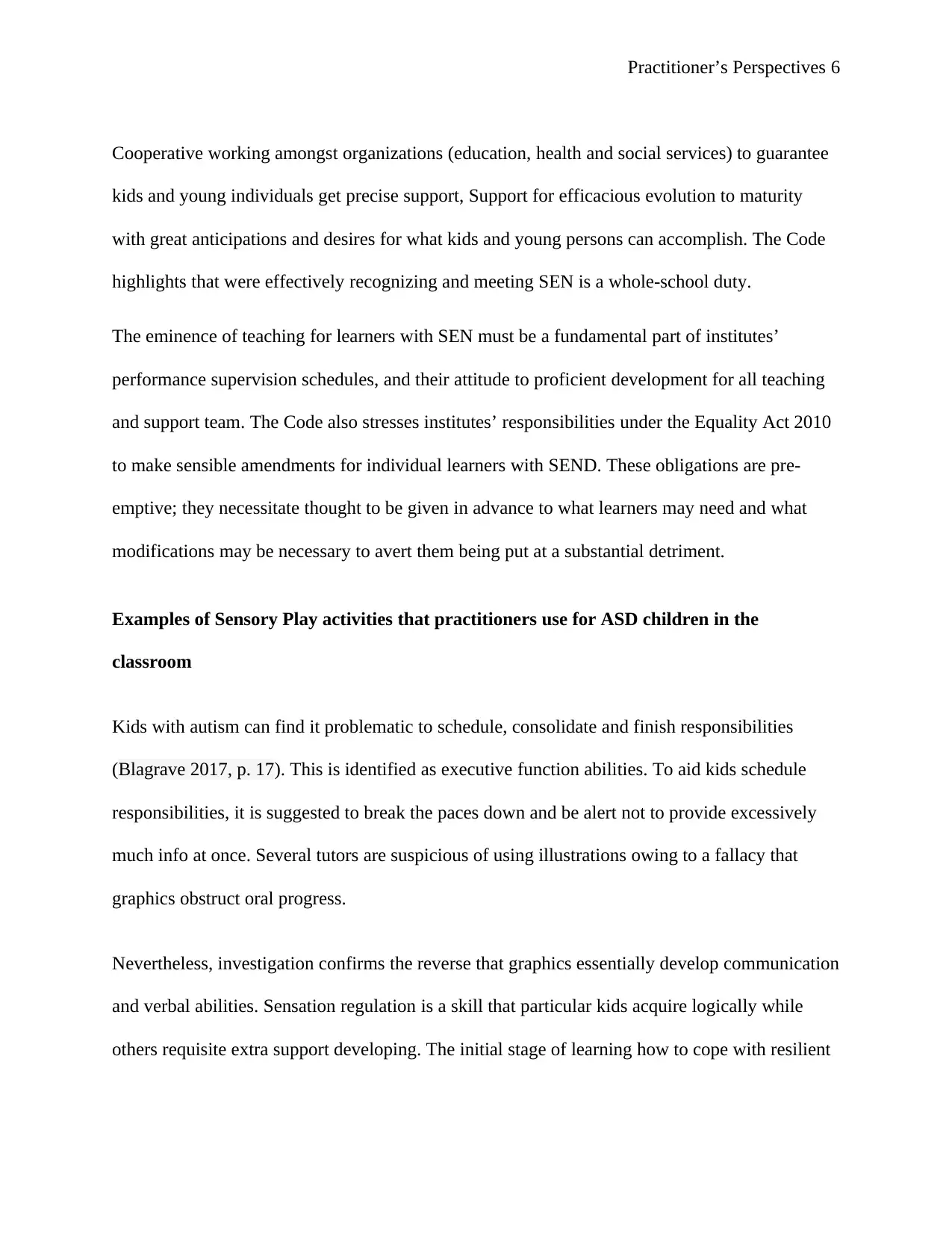
Practitioner’s Perspectives 6
Cooperative working amongst organizations (education, health and social services) to guarantee
kids and young individuals get precise support, Support for efficacious evolution to maturity
with great anticipations and desires for what kids and young persons can accomplish. The Code
highlights that were effectively recognizing and meeting SEN is a whole-school duty.
The eminence of teaching for learners with SEN must be a fundamental part of institutes’
performance supervision schedules, and their attitude to proficient development for all teaching
and support team. The Code also stresses institutes’ responsibilities under the Equality Act 2010
to make sensible amendments for individual learners with SEND. These obligations are pre-
emptive; they necessitate thought to be given in advance to what learners may need and what
modifications may be necessary to avert them being put at a substantial detriment.
Examples of Sensory Play activities that practitioners use for ASD children in the
classroom
Kids with autism can find it problematic to schedule, consolidate and finish responsibilities
(Blagrave 2017, p. 17). This is identified as executive function abilities. To aid kids schedule
responsibilities, it is suggested to break the paces down and be alert not to provide excessively
much info at once. Several tutors are suspicious of using illustrations owing to a fallacy that
graphics obstruct oral progress.
Nevertheless, investigation confirms the reverse that graphics essentially develop communication
and verbal abilities. Sensation regulation is a skill that particular kids acquire logically while
others requisite extra support developing. The initial stage of learning how to cope with resilient
Cooperative working amongst organizations (education, health and social services) to guarantee
kids and young individuals get precise support, Support for efficacious evolution to maturity
with great anticipations and desires for what kids and young persons can accomplish. The Code
highlights that were effectively recognizing and meeting SEN is a whole-school duty.
The eminence of teaching for learners with SEN must be a fundamental part of institutes’
performance supervision schedules, and their attitude to proficient development for all teaching
and support team. The Code also stresses institutes’ responsibilities under the Equality Act 2010
to make sensible amendments for individual learners with SEND. These obligations are pre-
emptive; they necessitate thought to be given in advance to what learners may need and what
modifications may be necessary to avert them being put at a substantial detriment.
Examples of Sensory Play activities that practitioners use for ASD children in the
classroom
Kids with autism can find it problematic to schedule, consolidate and finish responsibilities
(Blagrave 2017, p. 17). This is identified as executive function abilities. To aid kids schedule
responsibilities, it is suggested to break the paces down and be alert not to provide excessively
much info at once. Several tutors are suspicious of using illustrations owing to a fallacy that
graphics obstruct oral progress.
Nevertheless, investigation confirms the reverse that graphics essentially develop communication
and verbal abilities. Sensation regulation is a skill that particular kids acquire logically while
others requisite extra support developing. The initial stage of learning how to cope with resilient
⊘ This is a preview!⊘
Do you want full access?
Subscribe today to unlock all pages.

Trusted by 1+ million students worldwide
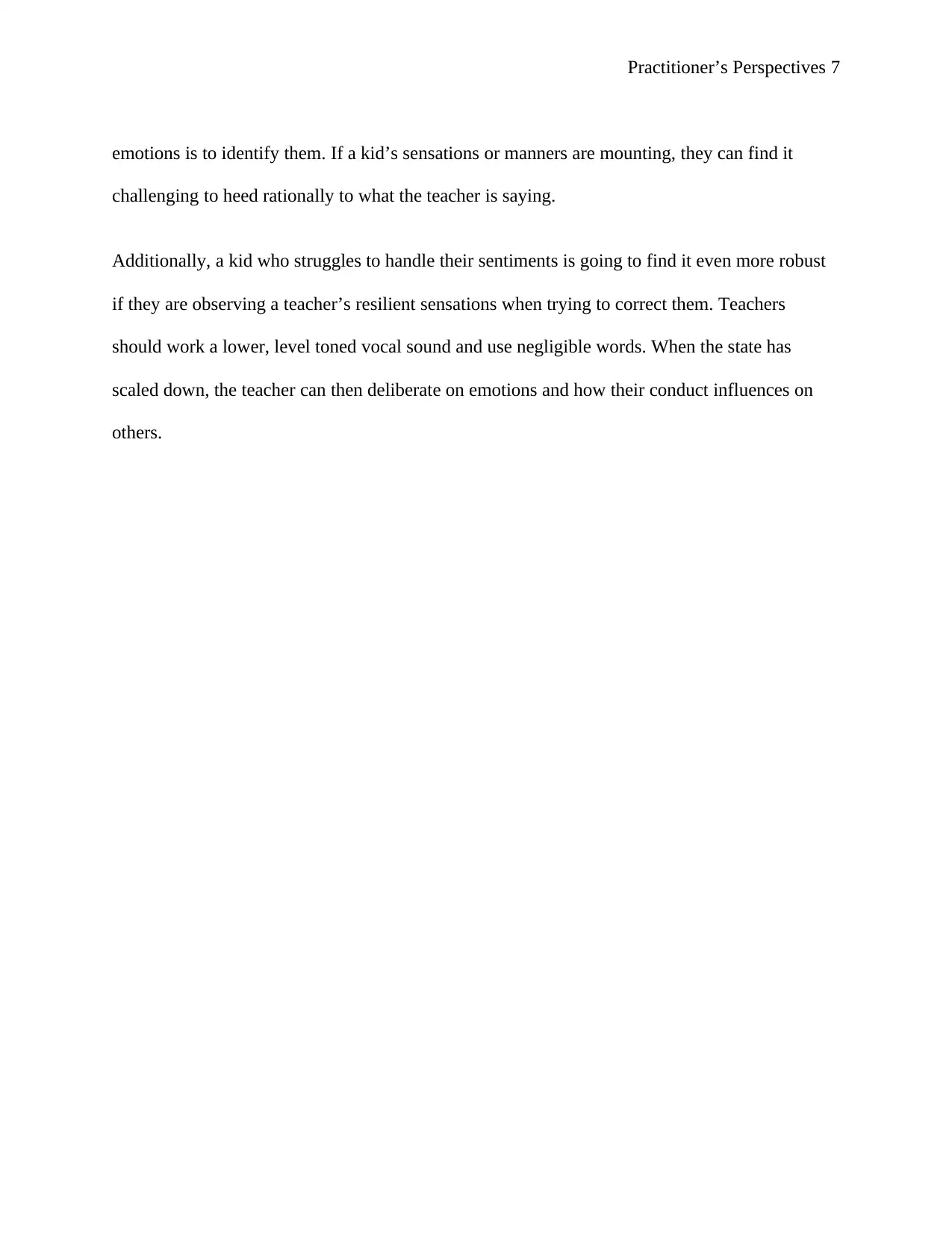
Practitioner’s Perspectives 7
emotions is to identify them. If a kid’s sensations or manners are mounting, they can find it
challenging to heed rationally to what the teacher is saying.
Additionally, a kid who struggles to handle their sentiments is going to find it even more robust
if they are observing a teacher’s resilient sensations when trying to correct them. Teachers
should work a lower, level toned vocal sound and use negligible words. When the state has
scaled down, the teacher can then deliberate on emotions and how their conduct influences on
others.
emotions is to identify them. If a kid’s sensations or manners are mounting, they can find it
challenging to heed rationally to what the teacher is saying.
Additionally, a kid who struggles to handle their sentiments is going to find it even more robust
if they are observing a teacher’s resilient sensations when trying to correct them. Teachers
should work a lower, level toned vocal sound and use negligible words. When the state has
scaled down, the teacher can then deliberate on emotions and how their conduct influences on
others.
Paraphrase This Document
Need a fresh take? Get an instant paraphrase of this document with our AI Paraphraser
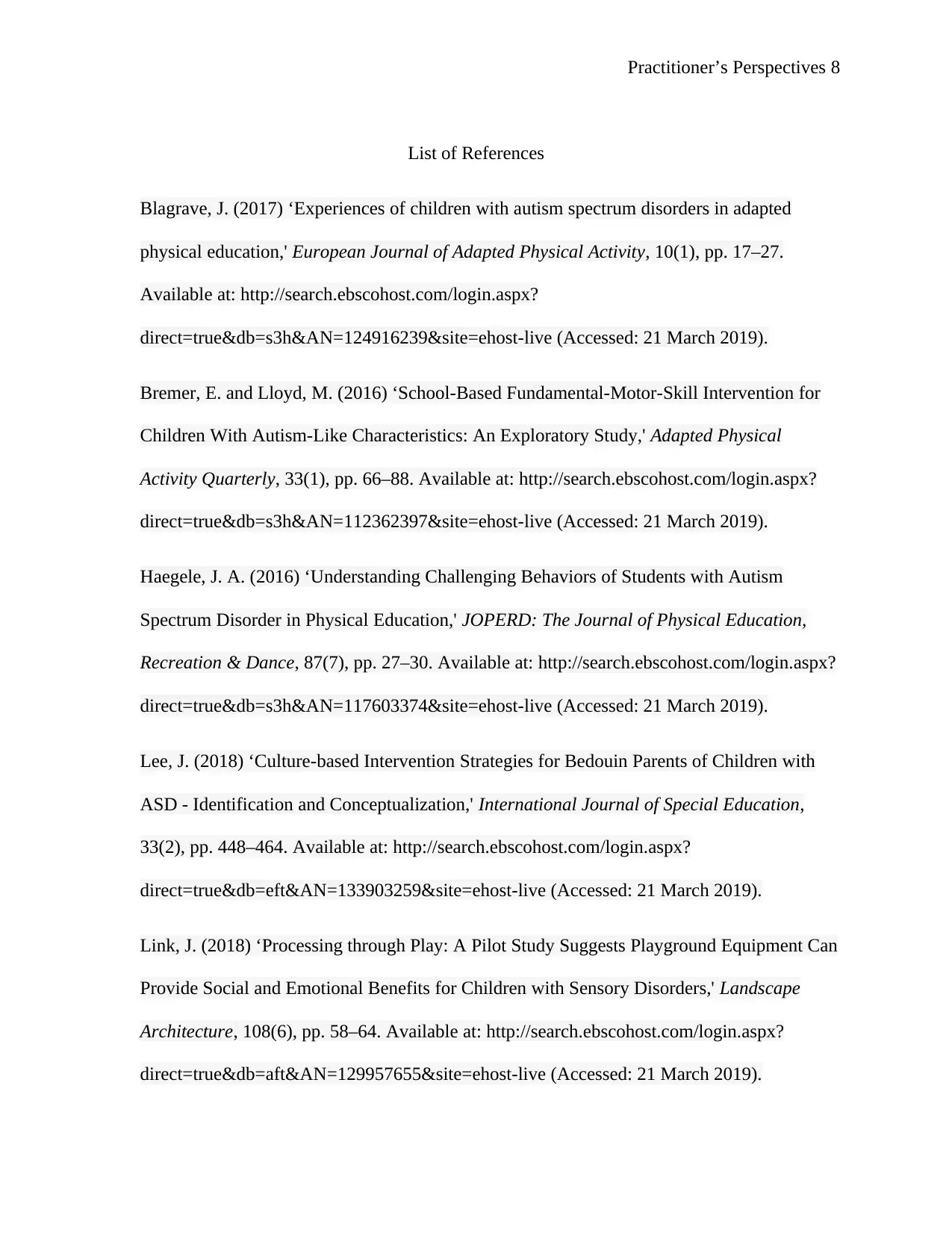
Practitioner’s Perspectives 8
List of References
Blagrave, J. (2017) ‘Experiences of children with autism spectrum disorders in adapted
physical education,' European Journal of Adapted Physical Activity, 10(1), pp. 17–27.
Available at: http://search.ebscohost.com/login.aspx?
direct=true&db=s3h&AN=124916239&site=ehost-live (Accessed: 21 March 2019).
Bremer, E. and Lloyd, M. (2016) ‘School-Based Fundamental-Motor-Skill Intervention for
Children With Autism-Like Characteristics: An Exploratory Study,' Adapted Physical
Activity Quarterly, 33(1), pp. 66–88. Available at: http://search.ebscohost.com/login.aspx?
direct=true&db=s3h&AN=112362397&site=ehost-live (Accessed: 21 March 2019).
Haegele, J. A. (2016) ‘Understanding Challenging Behaviors of Students with Autism
Spectrum Disorder in Physical Education,' JOPERD: The Journal of Physical Education,
Recreation & Dance, 87(7), pp. 27–30. Available at: http://search.ebscohost.com/login.aspx?
direct=true&db=s3h&AN=117603374&site=ehost-live (Accessed: 21 March 2019).
Lee, J. (2018) ‘Culture-based Intervention Strategies for Bedouin Parents of Children with
ASD - Identification and Conceptualization,' International Journal of Special Education,
33(2), pp. 448–464. Available at: http://search.ebscohost.com/login.aspx?
direct=true&db=eft&AN=133903259&site=ehost-live (Accessed: 21 March 2019).
Link, J. (2018) ‘Processing through Play: A Pilot Study Suggests Playground Equipment Can
Provide Social and Emotional Benefits for Children with Sensory Disorders,' Landscape
Architecture, 108(6), pp. 58–64. Available at: http://search.ebscohost.com/login.aspx?
direct=true&db=aft&AN=129957655&site=ehost-live (Accessed: 21 March 2019).
List of References
Blagrave, J. (2017) ‘Experiences of children with autism spectrum disorders in adapted
physical education,' European Journal of Adapted Physical Activity, 10(1), pp. 17–27.
Available at: http://search.ebscohost.com/login.aspx?
direct=true&db=s3h&AN=124916239&site=ehost-live (Accessed: 21 March 2019).
Bremer, E. and Lloyd, M. (2016) ‘School-Based Fundamental-Motor-Skill Intervention for
Children With Autism-Like Characteristics: An Exploratory Study,' Adapted Physical
Activity Quarterly, 33(1), pp. 66–88. Available at: http://search.ebscohost.com/login.aspx?
direct=true&db=s3h&AN=112362397&site=ehost-live (Accessed: 21 March 2019).
Haegele, J. A. (2016) ‘Understanding Challenging Behaviors of Students with Autism
Spectrum Disorder in Physical Education,' JOPERD: The Journal of Physical Education,
Recreation & Dance, 87(7), pp. 27–30. Available at: http://search.ebscohost.com/login.aspx?
direct=true&db=s3h&AN=117603374&site=ehost-live (Accessed: 21 March 2019).
Lee, J. (2018) ‘Culture-based Intervention Strategies for Bedouin Parents of Children with
ASD - Identification and Conceptualization,' International Journal of Special Education,
33(2), pp. 448–464. Available at: http://search.ebscohost.com/login.aspx?
direct=true&db=eft&AN=133903259&site=ehost-live (Accessed: 21 March 2019).
Link, J. (2018) ‘Processing through Play: A Pilot Study Suggests Playground Equipment Can
Provide Social and Emotional Benefits for Children with Sensory Disorders,' Landscape
Architecture, 108(6), pp. 58–64. Available at: http://search.ebscohost.com/login.aspx?
direct=true&db=aft&AN=129957655&site=ehost-live (Accessed: 21 March 2019).
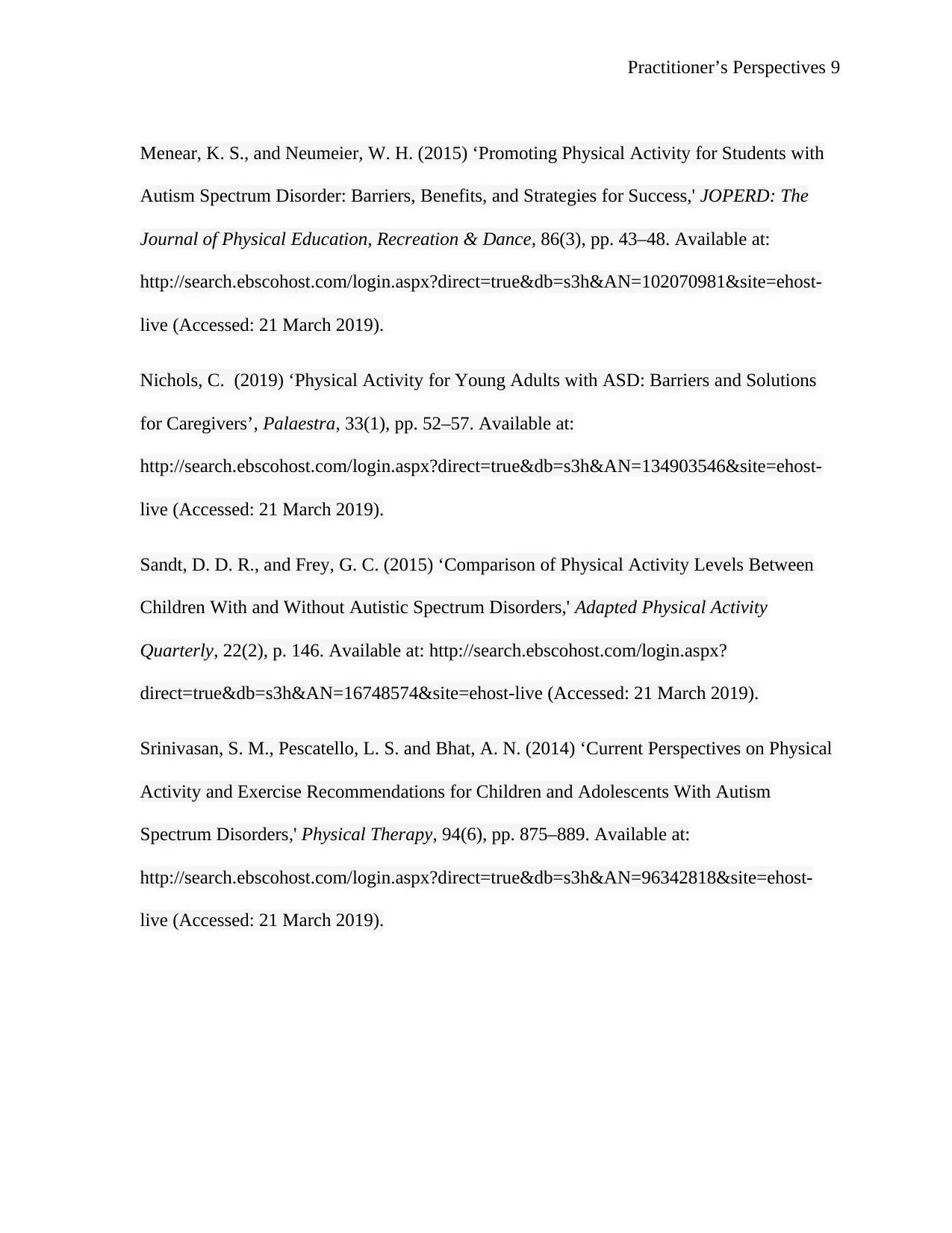
Practitioner’s Perspectives 9
Menear, K. S., and Neumeier, W. H. (2015) ‘Promoting Physical Activity for Students with
Autism Spectrum Disorder: Barriers, Benefits, and Strategies for Success,' JOPERD: The
Journal of Physical Education, Recreation & Dance, 86(3), pp. 43–48. Available at:
http://search.ebscohost.com/login.aspx?direct=true&db=s3h&AN=102070981&site=ehost-
live (Accessed: 21 March 2019).
Nichols, C. (2019) ‘Physical Activity for Young Adults with ASD: Barriers and Solutions
for Caregivers’, Palaestra, 33(1), pp. 52–57. Available at:
http://search.ebscohost.com/login.aspx?direct=true&db=s3h&AN=134903546&site=ehost-
live (Accessed: 21 March 2019).
Sandt, D. D. R., and Frey, G. C. (2015) ‘Comparison of Physical Activity Levels Between
Children With and Without Autistic Spectrum Disorders,' Adapted Physical Activity
Quarterly, 22(2), p. 146. Available at: http://search.ebscohost.com/login.aspx?
direct=true&db=s3h&AN=16748574&site=ehost-live (Accessed: 21 March 2019).
Srinivasan, S. M., Pescatello, L. S. and Bhat, A. N. (2014) ‘Current Perspectives on Physical
Activity and Exercise Recommendations for Children and Adolescents With Autism
Spectrum Disorders,' Physical Therapy, 94(6), pp. 875–889. Available at:
http://search.ebscohost.com/login.aspx?direct=true&db=s3h&AN=96342818&site=ehost-
live (Accessed: 21 March 2019).
Menear, K. S., and Neumeier, W. H. (2015) ‘Promoting Physical Activity for Students with
Autism Spectrum Disorder: Barriers, Benefits, and Strategies for Success,' JOPERD: The
Journal of Physical Education, Recreation & Dance, 86(3), pp. 43–48. Available at:
http://search.ebscohost.com/login.aspx?direct=true&db=s3h&AN=102070981&site=ehost-
live (Accessed: 21 March 2019).
Nichols, C. (2019) ‘Physical Activity for Young Adults with ASD: Barriers and Solutions
for Caregivers’, Palaestra, 33(1), pp. 52–57. Available at:
http://search.ebscohost.com/login.aspx?direct=true&db=s3h&AN=134903546&site=ehost-
live (Accessed: 21 March 2019).
Sandt, D. D. R., and Frey, G. C. (2015) ‘Comparison of Physical Activity Levels Between
Children With and Without Autistic Spectrum Disorders,' Adapted Physical Activity
Quarterly, 22(2), p. 146. Available at: http://search.ebscohost.com/login.aspx?
direct=true&db=s3h&AN=16748574&site=ehost-live (Accessed: 21 March 2019).
Srinivasan, S. M., Pescatello, L. S. and Bhat, A. N. (2014) ‘Current Perspectives on Physical
Activity and Exercise Recommendations for Children and Adolescents With Autism
Spectrum Disorders,' Physical Therapy, 94(6), pp. 875–889. Available at:
http://search.ebscohost.com/login.aspx?direct=true&db=s3h&AN=96342818&site=ehost-
live (Accessed: 21 March 2019).
⊘ This is a preview!⊘
Do you want full access?
Subscribe today to unlock all pages.

Trusted by 1+ million students worldwide
1 out of 9
Your All-in-One AI-Powered Toolkit for Academic Success.
+13062052269
info@desklib.com
Available 24*7 on WhatsApp / Email
![[object Object]](/_next/static/media/star-bottom.7253800d.svg)
Unlock your academic potential
Copyright © 2020–2025 A2Z Services. All Rights Reserved. Developed and managed by ZUCOL.